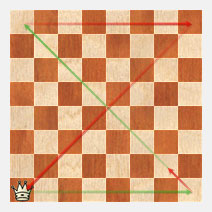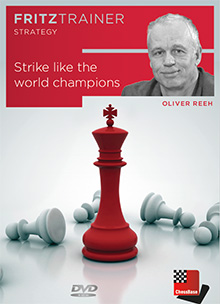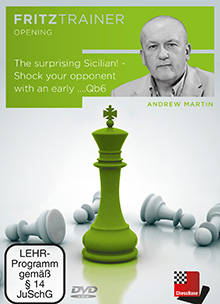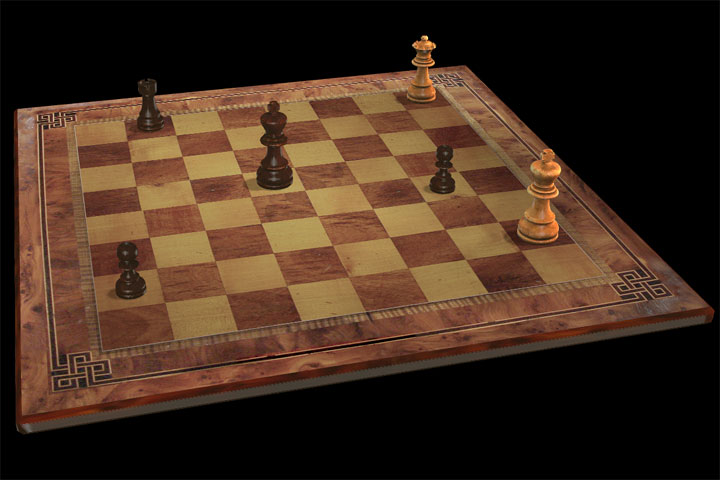If you haven't already, read part 1: Different Thinking
Focusing on Isolated Elements
Suppose a player finishes his tournament game and boasts to his friends: “I managed to capture en passant twice”, or “I succeeded in executing a pin [or fork or clearance of square].” He would probably be advised to check his head at the local psychiatric clinic. Giving a discovered check or exchanging pieces, likewise, are not goals in a chess game, just means to annihilate the opponent and score the full point.
Composition fans, on the other hand, are very interested in fractions of the occurrences, and to execute a theme is considered a goal. This is mainly seen in problems, and less commonly in studies. Readers have probably heard of such strange jargon concepts as ‘Bristol’ and ‘Turton’. Here is another one: ‘Albino’.

[Event "1-2 prize, Zadatschi y Etjudi 2008"] [Site "?"] [Date "2008.??.??"] [Round "?"] [White "Chepizhny, Victor"] [Black "White to play and mate in 3"] [Result "1-0"] [Annotator "Amatzia Avni"] [SetUp "1"] [FEN "7b/8/2p2r2/2p1Q1n1/1pP3P1/1PBk1PP1/R2P2nq/2KR1N2 w - - 0 1"] [PlyCount "5"] [EventDate "2008.??.??"] [SourceDate "2018.02.28"] [SourceVersionDate "2018.02.28"] 1. Ba1 $1 {Threatening 2.Qc3+ bxc3 (or 2...Ke2 3.d4#) 3.dxc3#.} Nxf3 (1... Rxf3 2. Qe2+ Kxe2 3. d4#) (1... Qh7 2. Qe3+ Nxe3 3. dxe3#) 2. Qe4+ $1 Kxe4 3. d3# { The d-pawn mates Black in all four possible ways, which carries out the theme. In addition, a white queen is sacrificed in each of Black’s defences. This symmetry thing is alien to the practical player, but means a lot to composers.} 1-0
 What’s so special in the following problem, you may wonder? The solution is easy and an average club player could be expected to find it in no time.
What’s so special in the following problem, you may wonder? The solution is easy and an average club player could be expected to find it in no time.
But look at the moves of the solution! To achieve victory, the white queen had to visit all four corners of the board.
Aren’t you thrilled?

[Event "1-2 prize, Nona 2005"] [Site "?"] [Date "2005.??.??"] [Round "?"] [White "Oleg Pervakov & Karen Sumbatyan"] [Black "White to play and win"] [Result "1-0"] [Annotator "Amatzia Avni"] [SetUp "1"] [FEN "1r5Q/8/8/3k4/6p1/8/p6K/8 w - - 0 1"] [PlyCount "13"] [EventDate "2005.??.??"] [SourceDate "2018.02.28"] [SourceVersionDate "2018.02.28"] 1. Qa1 $1 g3+ 2. Kh3 ({Not} 2. Kxg3 Rb3+ 3. Kf2 Ra3 {draws.}) 2... Ra8 3. Qh1+ g2 $1 4. Qxg2+ Kc4 5. Qxa8 Kb3 6. Qh8 Kc2 7. Qa1 1-0
Sometimes the beauty arises from a single move, which leaves the onlooker breathless.

[Event "1st prize, StrateGems 1998"] [Site "?"] [Date "1998.??.??"] [Round "?"] [White "Vukcevich, Milan"] [Black "Mate in three"] [Result "*"] [Annotator "Amatzia Avni"] [SetUp "1"] [FEN "5nbq/6p1/4p3/8/6N1/3Q4/PPKP1PPR/RB4k1 w - - 0 1"] [PlyCount "3"] [EventDate "1998.??.??"] [SourceDate "2018.02.28"] [SourceVersionDate "2018.02.28"] {The paradoxical key-move creates a very strong impression.} 1. Qh7 $3 { Pure magic. The threat is 2.Rh1+ Kxg2 3.Qe4#. The queen can be captured in three ways, but each one is met with a quiet king move, with mate to follow:} Qxh7+ (1... Bxh7+ 2. Kb3) (1... Nxh7 2. Kd3) ({Other defences are} 1... g6) ( 1... Kf1) (1... Ng6 {With a bit of effort, readers will find the solutions to them.}) 2. Kc3 *
Searching for Records
A problemist is frequently interested in breaking a record: to show symmetrical variations of a theme (an ‘echo’), or various defences of Black in a mate problem which are encountered with unique mates after each defence, etc. Promoting a passed pawn to a light-squared bishop has been done numerous times, so how about creating a composition which demonstrates many non-queen promotions? The next study, which received a special commendation, is an example, even if the initial position is artificial.

[Event "Ceskoslovensky Shach, 2013"] [Site "?"] [Date "2013.??.??"] [Round "?"] [White "Mikhail Zinar"] [Black "White to play and win"] [Result "1-0"] [Annotator "Amatzia Avni"] [SetUp "1"] [FEN "2r3r1/PPPPP1PP/n1b4n/2P5/4k3/6Bp/2p2p1p/2N2RbK w - - 0 1"] [PlyCount "16"] [EventDate "2013.??.??"] [SourceDate "2018.02.28"] [SourceVersionDate "2018.02.28"] {Black just needs to lift his king in the air and declare ‘mate!’, so White’s moves are directed against the bishop on c6.} 1. b8=N $1 ({And not} 1. d8=N $2 Bd5) 1... Nxb8 ({Or if} 1... Bd5 2. d8=Q) 2. axb8=N ({Side-stepping } 2. d8=N $2 Ke3+ 3. Nxc6 Nxc6) 2... Rxb8 3. cxb8=N $1 Rxb8 4. d8=N $1 Rxd8 5. exd8=N $1 {[#]Five consecutive knight promotions!} Bd5 6. g8=B $1 ({This time the under-promotion is directed against stalemate:} 6. g8=Q $2 Nf7 7. Qxf7 Ke3+ 8. Qxd5) 6... Nxg8 7. hxg8=B $1 ({Again if} 7. hxg8=Q $2 Ke3+ 8. Qxd5 {and stalemate.}) {whereas if} 7... Ke3+ 8. Bxd5 {Black’s king can move to the d-file.} Kd4 {All in all, seven successive under-promotions, which is quite an achievement.} 1-0
It is never good enough...
A practical player who discovers a variation which wins him a rook will usually play it without any further search for a superior alternative. He will opt for the variation because it is sufficient for gaining the full point; looking for the win of a whole queen or a mate possibility, especially under severe constraints of time, is looked upon as a waste of energy.
Problemists evaluate things differently. Even if their study or problem is sound (that is, correct), interesting and attractive, they will always look for improvements. As such, composers are always seeking a better setting to express their ideas. They constantly improve existing works — of others and of themselves.
In 1999 I composed the following study:
Although it is correct and of reasonable level, I was not satisfied and eventually succeeded in finding a better setting, in which the solution is lengthened by one move, and — what’s crucial — more pieces are active during the solution. This raised the level of the work and it entered the FIDE Album anthology.

[Event "Hon Mention, Chess in Israel 1999"] [Site "?"] [Date "1999.??.??"] [Round "?"] [White "Avni, Amatzia"] [Black "White to play and draw"] [Result "1/2-1/2"] [Annotator "Amatzia Avni"] [SetUp "1"] [FEN "6r1/2R3pk/q1n1p3/4N2K/b3P3/4P3/2Q5/8 w - - 0 1"] [PlyCount "12"] [EventDate "1999.??.??"] [SourceDate "2018.02.28"] [SourceVersionDate "2018.02.28"] 1. Qh2 ({And not} 1. Nf7 $2 Qa5+ 2. e5+ g6+ (2... Bxc2 $2 3. Ng5+ Kh8 4. Nf7+ Kh7 5. Ng5+ {is only a draw.}) 3. Kg4 ({or} 3. Kg5 Bxc2) 3... Qxc7 4. Ng5+ Kg7 5. Nxe6+ Kf7 {when Black wins.}) 1... Rh8 $1 ({Naturally not} 1... Re8 $4 2. Kg5+ Kg8 3. Rxg7+) 2. Nf7 (2. Nf7) ({Avoiding} 2. Kg5+ $2 Kg8 3. Qf4 Nxe5) 2... Kg8+ $1 3. Nxh8 Qa5+ ({Or if} 3... Bd1+ 4. Kh4 $1 Kxh8 $2 5. Kg3+) 4. Kg6 $1 ({ Further precision, as} 4. Kg4 Ne5+ 5. Kh3 Qxc7 6. Ng6 Qf7 7. Nxe5 Qh5+ 8. Kg2 Qe2+ 9. Kh1 Qxe3 10. Qg2 Qc1+ 11. Kh2 Qf4+ 12. Qg3 Qxe4 {is a technical win for Black.}) ({or} 4. Kh4 Kxh8) 4... Ne5+ 5. Qxe5 $1 Be8+ $1 {This seems to be a killer, except for a stalemate defence:} ({Not} 5... Qxe5 6. Rc8+) 6. Rf7 Qxe5 1/2-1/2
Players and problemists have a lot in common, if only because they use the same 64 squares, the board and chess pieces. They also have many differences, as I have demonstrated. My list of differences is not conclusive (for instance, originality is only ‘nice to have’ for players, but is absolutely crucial for problemists, to the point that the lack of it may empty all value from their works), but hopefully is rich enough to convey the message.
Re-read part one
About the author

Amatzia Avni is an Israeli psychologist, a FIDE Master in both over-the-board play and composition. He is the author of numerous books, among them The Grandmaster’s Mind (Gambit 2004, Russian Chess House 2016), and The Amazing Chess Adventures of Baron Munchausen (Mongoose Press, 2011).
The above article was reproduced from Chess Magazine April/2018, with kind permission.
About CHESS Magazine

CHESS Magazine was established in 1935 by B.H. Wood who ran it for over fifty years. It is published each month by the London Chess Centre and is edited by IM Richard Palliser and Matt Read. The Executive Editor is Malcolm Pein, who organises the London Chess Classic.
CHESS is mailed to subscribers in over 50 countries. You can subscribe from Europe and Asia at a specially discounted rate for first timers, or subscribe from North America.
UK’s most popular CHESS Magazine — established 1935! All the regular features of the UK’s best-selling CHESS magazine plus more! In this issue:
- Grandmasters Down Your Local – Tim Wall’s Northumbria Masters saw plenty of fighting chess
- Brought to Book – Teeside continues to blaze the way for CSC, as Sean Marsh explains
- Find the Winning Moves – Can you do as well as the players at Gibraltar and the 4NCL?
- Vintage Vishy – The World Rapid Champion triumphed at the Tal Memorial
- The Stars of the 4NCL – Tamas Fodor leads the 4NCL big hitters with 6/6 thus far
- How Good Is Your Chess? – Daniel King looks back on a classic victory by Levon Aronian
- The Bunratty Experience – Chess novice Tanya Jones checks out Ireland’s best weekender
- Beer, Blitz and Bunratty – There was much exciting chess during the 25th Bunratty Congress
- Different Thinking – Amatzia Avni compares over the board play with chess compositions
- Instincts: Optimism & Pessimism – Matthew Lunn has been troubled by his instincts letting him down
Download a free PDF preview of this issue!

ChessBase products from Chess & Bridge
 Strike like the World Champions
Strike like the World Champions
Oliver Reeh, PC-DVD; running time: 9 hours,
30 minutes
RRP £26.95 SUBSCRIBERS £24.25
The combination of Oliver Reeh and Wesley So might not have worked brilliantly in ChessBase’s Hamburg studio, but now we get to see the German IM and experienced presenter in his own right, and there will be no complaints about the length of this DVD. Reeh’s choice of subject is the most brilliant attacks and concluding combinations played by the 16 world champions, which are all presented in interactive format, meaning keen viewers can try and work out the solutions for themselves. Some of the games are rather well known, but plenty are not and the club player relatively new to the game, or looking for an inspirational refresher course, should be well educated by the wealth of sacrifices on offer which are largely clearly explained by Reeh.
Order online from
The London Chess Centre or Chess4Less (USA)
 The Surprising Sicilian – Shock Your Opponent with an early ...Qb6
The Surprising Sicilian – Shock Your Opponent with an early ...Qb6
Andrew Martin, PC-DVD; running time: 5 hours, 19 minutes
RRP £26.95 SUBSCRIBERS £24.25
Andrew Martin has certainly been busy of late and here promotes the Kveinys variation as an ideal weapon for the club player, as well as a surprise weapon for even stronger players. And what is the Kveinys? 1 e4 c5 2 Nf3 e6 3 d4 cxd4 4 Nxd4 Qb6 can lead to Scheveningen-type play, but ideally where White is away from the comfortable blanket of his or her knowledge of opening theory. At lower levels there are some pitfalls white players must avoid and even if they know their theory, the main lines are playable for Black, as shown by Peter Svidler and Judit Polgar.
Order online from
The London Chess Centre or Chess4Less (USA)
You can also find these products in the ChessBase Shop



















 What’s so special in the following problem, you may wonder? The solution is easy and an average club player could be expected to find it in no time.
What’s so special in the following problem, you may wonder? The solution is easy and an average club player could be expected to find it in no time.


 Strike like the World Champions
Strike like the World Champions The Surprising Sicilian – Shock Your Opponent with an early ...Qb6
The Surprising Sicilian – Shock Your Opponent with an early ...Qb6




